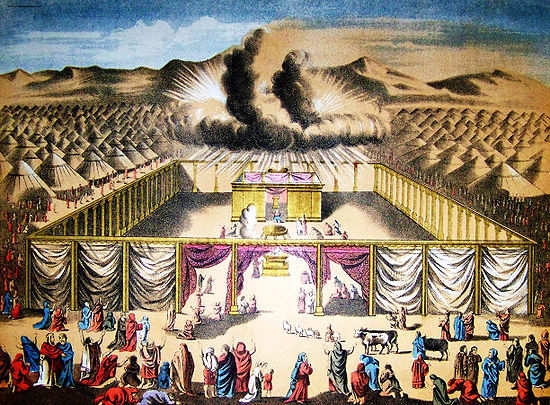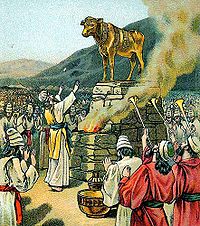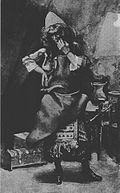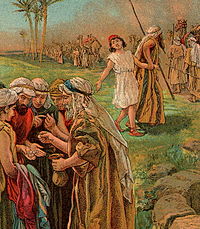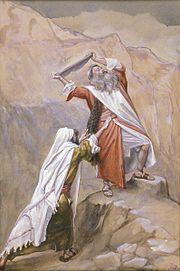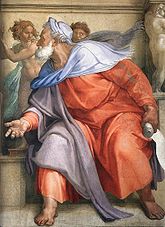- Pekudei
-
Pekudei, Pekude, Pekudey, P’kude, or P’qude (פְקוּדֵי — Hebrew for "amounts of,” the second word, and the first distinctive word, in the parshah) is the 23rd weekly Torah portion (parshah) in the annual Jewish cycle of Torah reading and the 11th and last in the book of Exodus. It constitutes Exodus 38:21–40:38. Jews in the Diaspora read it the 22nd or 23rd Sabbath after Simchat Torah, generally in March.
The lunisolar Hebrew calendar contains up to 55 weeks, the exact number varying between 50 in common years and 54 or 55 in leap years. In leap years (for example, 2011, 2014, and 2016), parshah Pekudei is read separately. In common years (for example, 2012, 2013, 2015, 2017, and 2018), parshah Pekudei is combined with the previous parshah, Vayakhel, to help achieve the needed number of weekly readings.
Contents
Summary
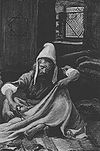 The Tailor (watercolor circa 1896–1902 by James Tissot)
The Tailor (watercolor circa 1896–1902 by James Tissot)
At Moses’ direction, Aaron’s son Ithamar oversaw the accounts of the Tabernacle, and the text sets forth the amounts of gold, silver, and copper that Bezalel, Oholiab, and their coworkers used. (Exodus 38:21–31.) The silver came from the half-shekel a head for each man 20 years old and older who was counted in the census. (Exodus 38:25–26.) Bezalel, Oholiab, and their coworkers made the priests’ vestments, the ephod, the breastpiece, the robe, the tunics of fine linen, and the frontlet inscribed “Holy to the Lord” — just as God had commanded Moses. (Exodus 39:1–32.) Then they brought the Tabernacle and all its furnishings to Moses, and he blessed them. (Exodus 39:33–43.)
God told Moses to set up the Tabernacle, and Moses did just as God had commanded him, on the first day of the second year of the Exodus. (Exodus 40:1–33.)
When Moses finished the work, the cloud covered the Tent of Meeting, and God’s Presence filled the Tabernacle. (Exodus 40:33–34.) When the cloud lifted from the Tabernacle, the Israelites would set out, and when the cloud did not lift, they would not set out. (Exodus 40:35–37.) And God’s cloud rested over the Tabernacle by day, and fire would appear in it by night, throughout the Israelites’ journeys. (Exodus 40:38.)
In inner-Biblical interpretation
Exodus chapters 25–39
This is the pattern of instruction and construction of the Tabernacle and its furnishings:
Item Instruction Construction Order Verses Order Verses The Sabbath 16 Exodus 31:12–17 1 Exodus 35:1–3 Contributions 1 Exodus 25:1–9 2 Exodus 35:4–29 Craftspeople 15 Exodus 31:1–11 3 Exodus 35:30–36:7 Tabernacle 5 Exodus 26:1–37 4 Exodus 36:8–38 Ark 2 Exodus 25:10–22 5 Exodus 37:1–9 Table 3 Exodus 25:23–30 6 Exodus 37:10–16 Menorah 4 Exodus 25:31–40 7 Exodus 37:17–24 Altar of Incense 11 Exodus 30:1–10 8 Exodus 37:25–28 Anointing Oil 13 Exodus 30:22–33 9 Exodus 37:29 Incense 14 Exodus 30:34–38 10 Exodus 37:29 Altar of Sacrifice 6 Exodus 27:1–8 11 Exodus 38:1–7 Laver 12 Exodus 30:17–21 12 Exodus 38:8 Tabernacle Court 7 Exodus 27:9–19 13 Exodus 38:9–20 Priestly Garments 9 Exodus 28:1–43 14 Exodus 39:1–31 Ordination Ritual 10 Exodus 29:1–46 15 Leviticus 8:1–9:24 Lamp 8 Exodus 27:20–21 16 Numbers 8:1–4 In classical rabbinic interpretation
Exodus chapter 38
Rabbi Simeon son of Rabbi Ishmael interpreted the term “the Tabernacle of the testimony” in Exodus 38:21 to mean that the Tabernacle was God’s testimony to the whole world that God had forgiven Israel for having made the Golden Calf. Rabbi Isaac explained with a parable. A king took a wife whom he dearly loved. He became angry with her and left her, and her neighbors taunted her, saying that he would not return. Then the king sent her a message asking her to prepare the king’s palace and make the beds therein, for he was coming back to her on such-and-such a day. On that day, the king returned to her and became reconciled to her, entering her chamber and eating and drinking with her. Her neighbors at first did not believe it, but when they smelled the fragrant spices, they knew that the king had returned. Similarly, God loved Israel, bringing the Israelites to Mount Sinai, and giving them the Torah, but after only 40 days, they sinned with the Golden Calf. The heathen nations then said that God would not be reconciled with the Israelites. But when Moses pleaded for mercy on their behalf, God forgave them, as Numbers 14:20 reports, “And the Lord said: ‘I have pardoned according to your word.’” Moses then told God that even though he personally was quite satisfied that God had forgiven Israel, he asked that God might announce that fact to the nations. God replied that God would cause God’s Shechinah to dwell in their midst, and thus Exodus 25:8 says, “And let them make Me a sanctuary, that I may dwell among them.” And by that sign, God intended that all nations might know that God had forgiven the Israelites. And thus Exodus 38:21 calls it “the Tabernacle of the testimony,” because the Tabernacle was a testimony that God had pardoned the Israelites’ sins. (Exodus Rabbah 51:4.)
Rabbi Tanhuma said in the name of Rav Huna that when Exodus 38:22 reported that “Bezalel . . . made all that the Lord commanded Moses,” the verse did not say “that Moses commanded Bezalel,” and thus the verse taught that Bezalel was able to conceive on his own exactly what God told Moses at Sinai, even though Bezalel did not hear it from Moses. (Jerusalem Talmud Peah 5a.) Similarly, Rabbi Samuel bar Nahmani said in the name of Rabbi Johanan that Bezalel (whose name can be read betzel El, “in the shadow of God”) was so called because of his wisdom. When God told Moses (in Exodus 31:7) to tell Bezalel to make a tabernacle, an ark, and vessels, Moses reversed the order and told Bezalel to make an ark, vessels, and a tabernacle. Bezalel replied to Moses that as a rule, one first builds a house and then brings vessels into it, but Moses directed to make an ark, vessels, and a tabernacle. Bezalel asked where he would put the vessels. And Bezalel asked whether God had told Moses to make a tabernacle, an ark, and vessels. Moses replied that perhaps Bezalel had been in the shadow of God (betzel El) and had thus come to know this. (Babylonian Talmud Berakhot 55a.)
Doing the math implied by Exodus 36:4, Exodus 38:22, Joshua 14:7, and 1 Chronicles 2:19–20, the Gemara deduced that in earlier generations, a boy of eight could father children. Exodus 38:22 reports that “Bezalel, son of Uri, son of Hur, of the tribe of Judah, made all that the Lord had commanded Moses,” when they built the Tabernacle. And 1 Chronicles 2:19–20 reports that Caleb fathered the Hur who fathered Uri who fathered Bezalel. Exodus 36:4 reports that “wise men . . . wrought all the work of the Sanctuary,” so Bezalel must have been at least 13 years old to have been a man when he worked on the Tabernacle. A Baraita taught that Moses made the Tabernacle in the first year after the Exodus, and in the second, he erected it and sent out the spies, so the Gemara deduced that Bezalel must have been at least 14 years old when Moses sent out the spies, the year after Bezalel worked on the Tabernacle. And Joshua 14:7 reports that Caleb said that he was 40 years old when Moses sent him to spy out the land. Thus, the Gemara deduced that Caleb was only 26 years older than his great-grandson Bezalel. Deducting two years for the three pregnancies needed to create the three intervening generations, the Gemara concluded that each of Caleb, Hur, and Uri must have conceived his son at the age of eight. (Babylonian Talmud Sanhedrin 69b.)
 The Firmament (illustration from Camille Flammarion's 1888 L'atmosphère: météorologie populaire)
The Firmament (illustration from Camille Flammarion's 1888 L'atmosphère: météorologie populaire)
Rabbi Judah ben Simon taught that God required each of the Israelites to give a half-shekel (as reported in Exodus 38:26) because (as reported in Genesis 37:28) their ancestors had sold Joseph to the Ishmaelites for 20 shekels. (Genesis Rabbah 84:18.)
Exodus chapter 39
Rabbi Judah ben Pazi noted that a similar word appears in both Genesis 1:6 — where rakya is translated as “firmament” — and Exodus 39:3 — where vayraku is translated as “and they flattened.” He thus deduced from the usage in Exodus 39:3 that Genesis 1:6 taught that on the second day of creation, God spread the heavens flat like a cloth. (Jerusalem Talmud Berakhot 6a.) Or Rabbi Judah ben Simon deduced from Exodus 39:3 that Genesis 1:6 meant “let a lining be made for the firmament.” (Genesis Rabbah 4:2.)
A Baraita taught that the High Priest’s wore his mitre so that hair was visible between the headplate and the mitre described in Exodus 39:30–31. (Babylonian Talmud Zevachim 19a.)
Reading Exodus 39:33, “and they brought the Tabernacle,” a midrash taught that on the day that the Tabernacle was set up, the Israelites rejoiced greatly because God then dwelt in their midst. And the people sang the words of Song of Songs 3:11, “Go forth, O you daughters of Zion, and gaze upon King Solomon, even upon the crown wherewith his mother has crowned him in the day of his espousals, and in the day of the gladness of his heart.” “O you daughters of Zion” were the children who are distinguished as God’s from among the peoples. “And gaze upon King Solomon” meant “gaze upon a King to whom all peace belongs” (reading the name Solomon as a play on the word “His peace”) — that is, upon the King of kings, God. “Even upon the crown wherewith his mother has crowned him” referred to the Tabernacle, which was called a crown because just as a crown has beautiful designs, so was the Tabernacle beautifully designed. “In the day of his espousals” referred to Sinai (at the Revelation). “And in the day of the gladness of his heart” referred to Jerusalem (when God caused God’s presence to dwell in the Temple in Jerusalem). According to another explanation, “in the day of his espousals” was the day when God was with Israel at the Red Sea, and “in the day of the gladness of his heart” was when God’s presence dwelt in the Tent of Meeting. And according to yet another explanation, “in the day of his espousals” was in the Tabernacle, and “in the day of the gladness of his heart” was in the Temple (when they were erected). (Exodus Rabbah 52:5.)
Exodus chapter 40
Noting that Exodus 40:17 reports that “the tabernacle was reared up” — using the passive voice — a midrash told that when in Exodus 40:1–2 God told Moses to set up the Tabernacle, Moses protested that he did not know how to set it up. So God told Moses to begin working with his hands and make a show of setting it up, and the Tabernacle would stand up on its own. But God reassured Moses that God would record that Moses set it up, as Exodus 40:18 reports, “Moses reared up the tabernacle.” (Midrash Tanhuma Pekudei 11.)
Rav Assi of Hozna'ah deduced from the words, “And it came to pass in the first month of the second year, on the first day of the month,” in Exodus 40:17 that the Tabernacle was erected on the first of Nisan. With reference to this, a Tanna taught that the first of Nisan took ten crowns of distinction by virtue of the ten momentous events that occurred on that day. The first of Nisan was: (1) the first day of the Creation (as reported in Genesis 1:1–5), (2) the first day of the princes’ offerings (as reported in Numbers 7:10–17), (3) the first day for the priesthood to make the sacrificial offerings (as reported in Leviticus 9:1–21), (4) the first day for public sacrifice, (5) the first day for the descent of fire from Heaven (as reported in Leviticus 9:24), (6) the first for the priests’ eating of sacred food in the sacred area, (7) the first for the dwelling of the Shechinah in Israel (as implied by Exodus 25:8), (8) the first for the Priestly Blessing of Israel (as reported in Leviticus 9:22, employing the blessing prescribed by Numbers 6:22–27), (9) the first for the prohibition of the high places (as stated in Leviticus 17:3–4), and (10) the first of the months of the year (as instructed in Exodus 12:2). (Babylonian Talmud Shabbat 87b.)
In Deuteronomy 18:15, Moses foretold that “A prophet will the Lord your God raise up for you . . . like me,” and Rabbi Johanan thus taught that prophets would have to be, like Moses, strong, wealthy, wise, and meek. Strong, for Exodus 40:19 says of Moses, “he spread the tent over the Tabernacle,” and a Master taught that Moses himself spread it, and Exodus 26:16 reports, “Ten cubits shall be the length of a board.” Similarly, the strength of Moses can be derived from Deuteronomy 9:17, in which Moses reports, “And I took the two tablets, and cast them out of my two hands, and broke them,” and it was taught that the tablets were six handbreadths in length, six in breadth, and three in thickness. Wealthy, as Exodus 34:1 reports God’s instruction to Moses, “Carve yourself two tablets of stone,” and the Rabbis interpreted the verse to teach that the chips would belong to Moses. Wise, for Rav and Samuel both said that 50 gates of understanding were created in the world, and all but one were given to Moses, for Psalm 8:6 said of Moses, “You have made him a little lower than God.” Meek, for Numbers 12:3 reports, “Now the man Moses was very meek.” (Babylonian Talmud Nedarim 38a.)
Commandments
According to Maimonides and Sefer ha-Chinuch, there are no commandments in the parshah. (Maimonides. The Commandments: Sefer Ha-Mitzvoth of Maimonides. Translated by Charles B. Chavel, 2 vols. London: Soncino Press, 1967. ISBN 0-900689-71-4. Sefer HaHinnuch: The Book of [Mitzvah] Education. Translated by Charles Wengrov, 1:433. Jerusalem: Feldheim Pub., 1991. ISBN 0-87306-179-9.)
Haftarah
Generally
The haftarah for the parshah is:
Sephardi — 1 Kings 7:40–50
Both the parshah and the haftarah in 1 Kings 7:40–50 report the leader’s erection of the holy place — Moses’ setting up the Tabernacle in the parshah (Exodus 40:18), and Solomon’s building of the Temple in Jerusalem in the haftarah. (1 Kings 7:40–50.) Both the parshah and the haftarah report that the builders finished the work: “Moses finished the work” (וַיְכַל מֹשֶׁה, אֶת-הַמְּלָאכָה, vayechal Mosheh et ha-melachah) in Exodus 40:33, and “so Hiram made an end of doing all the work” (וַיְכַל חִירָם, לַעֲשׂוֹת אֶת-כָּל-הַמְּלָאכָה, vayechal Chiram la’asot et kol ha-melachah) in 1 Kings 7:40.
Ashkenazi — 1 Kings 7:51–8:21
Similarly, both the parshah and the haftarah in 1 Kings 7:51–8:21 report the finishing of the leaders’ work: “Moses finished the work” (וַיְכַל מֹשֶׁה, אֶת-הַמְּלָאכָה, vayechal Mosheh et ha-melachah) in Exodus 40:33, and “all the work that king Solomon wrought . . . was finished” ( וַתִּשְׁלַם, כָּל-הַמְּלָאכָה, אֲשֶׁר עָשָׂה הַמֶּלֶךְ שְׁלֹמֹה, vatishlam kol ha-melachah asher asah ha-melech Shlomoh) in 1 Kings 7:51. And in both the parshah and the haftarah, a cloud and the Presence of the Lord fill the Sanctuary, indicating God’s approval. (Exodus 40:34–35; 1 Kings 8:10–11.)
On Shabbat Shekalim
When the parshah coincides with the special Sabbath Shabbat Shekalim (as it does in 2011 and 2014), the haftarah is 2 Kings 12:1–17.
On Shabbat Rosh Chodesh
When the parshah coincides with Shabbat Rosh Chodesh (as it did in 2008), the haftarah is Isaiah 66:1–24.
Parshah Vayakhel–Pekudei
When parshah Vayakhel is combined with parshah Pekudei, the haftarah is:
- for Ashkenazi Jews: 1 Kings 7:51–8:21
- for Sephardi Jews: 1 Kings 7:40–50
On Shabbat HaChodesh
When the parshah coincides with Shabbat HaChodesh ("Sabbath [of] the month," the special Sabbath preceding the Hebrew month of Nissan — as it does in 2013 and 2017), the haftarah is:
- for Ashkenazi Jews: Ezekiel 45:16–46:18.
- for Sephardi Jews: Ezekiel 45:18–46:15.
On Shabbat HaChodesh, Jews read Exodus 12:1–20, in which God commands that “This month [Nissan] shall be the beginning of months; it shall be the first month of the year” (Exodus 12:2), and in which God issued the commandments of Passover. (Exodus 12:3–20.) Similarly, the haftarah in Ezekiel 45:21–25 discusses Passover. In both the parshah and the haftarah, God instructs the Israelites to apply blood to doorposts. (Exodus 12:7; Ezekiel 45:19.)
On Shabbat Parah
When the parshah coincides with Shabbat Parah (the special Sabbath prior to Passover — as it does in 2012, 2015, 2018), the haftarah is:
- for Ashkenazi Jews: Ezekiel 36:16–38.
- for Sephardi Jews: Ezekiel 36:16–36.
On Shabbat Parah, the Sabbath of the red heifer, Jews read Numbers 19:1–22, which describes the rites of purification using the red heifer (פָרָה אֲדֻמָּה, parah adumah). Similarly, the haftarah in Ezekiel 36 also describes purification. In both the special reading and the haftarah in Ezekiel 36, sprinkled water cleansed the Israelites. (Numbers 19:18; Ezekiel 36:25.)
In the liturgy
A midrash taught that on the day that Moses completed construction of the Tabernacle (as reported in Exodus 40:33), he composed Psalm 91, which Jews read in the Pesukei D’Zimrah section of the morning Shacharit prayer service. (Menachem Davis. The Schottenstein Edition Siddur for the Sabbath and Festivals with an Interlinear Translation, 272. Brooklyn: Mesorah Publications, 2002. ISBN 1-57819-697-3.)
Further reading
The parshah has parallels or is discussed in these sources:
Biblical
- Psalm 78:5 (testimony); 93:5 (God's holy place); 133:2 (anointing Aaron).
Early nonrabbinic
- Philo. Who Is the Heir of Divine Things? 26:131. Alexandria, Egypt, early 1st Century C.E.. Reprinted in, e.g., The Works of Philo: Complete and Unabridged, New Updated Edition. Translated by Charles Duke Yonge, 287. Peabody, Mass.: Hendrickson Pub., 1993. ISBN 0-943575-93-1.
- Josephus, Antiquities of the Jews 3:6:1–10:1. Circa 93–94. Reprinted in, e.g., The Works of Josephus: Complete and Unabridged, New Updated Edition. Translated by William Whiston, 85–95. Peabody, Mass.: Hendrickson Pub., 1987. ISBN 0-913573-86-8.
Classical rabbinic
- Tosefta: Zevachim 1:8; Menachot 7:7–8. Land of Israel, circa 300 C.E. Reprinted in, e.g., The Tosefta: Translated from the Hebrew, with a New Introduction. Translated by Jacob Neusner, 2:1310, 1434–35. Peabody, Mass.: Hendrickson Pub., 2002. ISBN 1-56563-642-2.
- Genesis Rabbah 3:9; 4:2; 84:18. Land of Israel, 5th Century. Reprinted in, e.g., Midrash Rabbah: Genesis. Translated by H. Freedman and Maurice Simon, 1:25, 27; 2:783. London: Soncino Press, 1939. ISBN 0-900689-38-2.
- Jerusalem Talmud: Berakhot 6a; Peah 5a; Kilayim 76a; Sukkah 8a, 27a. Land of Israel, circa 400 C.E. Reprinted in, e.g., Talmud Yerushalmi. Edited by Chaim Malinowitz, Yisroel Simcha Schorr, and Mordechai Marcus, vols. 1, 3, 5, 22. Brooklyn: Mesorah Pubs., 2005–2009.
- Babylonian Talmud: Shabbat 28a, 87b; Yoma 4b, 6a, 12a–b, 32a, 71b; Sukkah 7b, 21a; Rosh Hashanah 3a; Taanit 29a; Megillah 29b; Yevamot 4b; Nedarim 38a; Sotah 37a, 38a; Sanhedrin 69b; Zevachim 19b, 22a, 58b, 119a–b; Menachot 62a, 98a, 99a; Chullin 138a; Bekhorot 5a, 44a; Arakhin 3b. Babylonia, 6th Century. Reprinted in, e.g., Talmud Bavli. Edited by Yisroel Simcha Schorr, Chaim Malinowitz, and Mordechai Marcus, 72 vols. Brooklyn: Mesorah Pubs., 2006.
Medieval
- Exodus Rabbah 51:1–52:5. 10th Century. 10th Century. Reprinted in, e.g., Midrash Rabbah: Exodus. Translated by S. M. Lehrman, 3:562–81. London: Soncino Press, 1939. ISBN 0-900689-38-2.
- Rashi. Commentary. Exodus 38–40. Troyes, France, late 11th Century. Reprinted in, e.g., Rashi. The Torah: With Rashi’s Commentary Translated, Annotated, and Elucidated. Translated and annotated by Yisrael Isser Zvi Herczeg, 2:507–24. Brooklyn: Mesorah Publications, 1994. ISBN 0-89906-027-7.
- Judah Halevi. Kuzari. 3:23. Toledo, Spain, 1130–1140. Reprinted in, e.g., Jehuda Halevi. Kuzari: An Argument for the Faith of Israel. Intro. by Henry Slonimsky, 162. New York: Schocken, 1964. ISBN 0-8052-0075-4.
- Zohar 2:220a–269a. Spain, late 13th Century.
Modern
- Thomas Hobbes. Leviathan, 4:44. England, 1651. Reprint edited by C. B. Macpherson, 643. Harmondsworth, England: Penguin Classics, 1982. ISBN 0140431950.
- Richard Elliott Friedman. “A Brilliant Mistake” and “The Sacred Tent.” In Who Wrote the Bible?, 161–87. New York: Summit Books, 1987. ISBN 0-671-63191-6.
- Gabriel Josipovici. “Building the Tabernacle.” In The Book of God: A Response to the Bible, 90–107. New Haven: Yale University Press, 1988. ISBN 0300043201.
- Jon D. Levenson. “Cosmos and Microcosm.” In Creation and the Persistence of Evil: The Jewish Drama of Divine Omnipotence, 78–99. San Francisco: Harper & Row, 1988. ISBN 0-06-254845-X.
- Craig R. Koester. Dwelling of God: The Tabernacle in the Old Testament, Intertestamental Jewish Literature, and the New Testament. Washington: Catholic Biblical Association of America, 1989. ISBN 0-915170-21-3.
- Alan Lew. This Is Real and You Are Completely Unprepared: The Days of Awe as a Journey of Transformation, 53–55. Boston: Little, Brown and Co., 2003. ISBN 0-316-73908-1.
External links
Texts
Commentaries
- Academy for Jewish Religion, California
- Aish.com
- American Jewish University
- Anshe Emes Synagogue, Los Angeles
- Bar-Ilan University
- Chabad.org
- eparsha.com
- G-dcast
- Jewish Agency for Israel
- Jewish Theological Seminary
- Miriam Aflalo
- MyJewishLearning.com
- Ohr Sameach
- Orthodox Union
- OzTorah, Torah from Australia
- Oz Ve Shalom — Netivot Shalom
- RabbiShimon.com
- Rabbi Shlomo Riskin
- Rabbi Shmuel Herzfeld
- Reconstructionist Judaism
- Sephardic Institute
- Shiur.com
- 613.org Jewish Torah Audio
- Tanach Study Center
- Torah from Dixie
- Torah.org
- TorahVort.com
- Union for Reform Judaism
- United Hebrew Congregations of the Commonwealth
- United Synagogue of Conservative Judaism
- What’s Bothering Rashi?
Weekly Torah Portions Genesis Bereishit · Noach · Lech-Lecha · Vayeira · Chayei Sarah · Toledot · Vayetze · Vayishlach · Vayeshev · Miketz · Vayigash · Vayechi
Exodus Leviticus Numbers Deuteronomy Devarim · Va'etchanan · Eikev · Re'eh · Shoftim · Ki Teitzei · Ki Tavo · Nitzavim · Vayelech · Haazinu · V'Zot HaBerachahCategories:- Weekly Torah readings
- Book of Exodus
Wikimedia Foundation. 2010.

